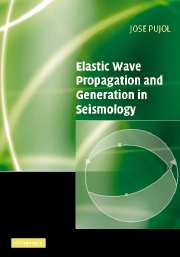Book contents
- Frontmatter
- Contents
- Preface
- Acknowledgements
- 1 Introduction to tensors and dyadics
- 2 Deformation. Strain and rotation tensors
- 3 The stress tensor
- 4 Linear elasticity – the elastic wave equation
- 5 Scalar and elastic waves in unbounded media
- 6 Plane waves in simple models with plane boundaries
- 7 Surface waves in simple models – dispersive waves
- 8 Ray theory
- 9 Seismic point sources in unbounded homogeneous media
- 10 The earthquake source in unbounded media
- 11 Anelastic attenuation
- Hints
- Appendices
- Bibliography
- Index
2 - Deformation. Strain and rotation tensors
Published online by Cambridge University Press: 12 November 2009
- Frontmatter
- Contents
- Preface
- Acknowledgements
- 1 Introduction to tensors and dyadics
- 2 Deformation. Strain and rotation tensors
- 3 The stress tensor
- 4 Linear elasticity – the elastic wave equation
- 5 Scalar and elastic waves in unbounded media
- 6 Plane waves in simple models with plane boundaries
- 7 Surface waves in simple models – dispersive waves
- 8 Ray theory
- 9 Seismic point sources in unbounded homogeneous media
- 10 The earthquake source in unbounded media
- 11 Anelastic attenuation
- Hints
- Appendices
- Bibliography
- Index
Summary
Introduction
Elasticity theory, which lies at the core of seismology, is most generally studied as a branch of continuum mechanics. Although this general approach is not required in introductory courses, it is adopted here for two reasons. First, it affords a number of insights either not provided, or not as easily derivable, when a more restricted approach is used. Secondly, it is essential to solve advanced seismology problems, as can be seen from the discussion in Box 8.5 of Aki and Richards (1980), and references therein, or from the book by Dahlen and Tromp (1998).
Continuum mechanics studies the deformation and motion of bodies ignoring the discrete nature of matter (molecules, atoms, subatomic particles), and “confines itself to relations among gross phenomena, neglecting the structure of the material on a smaller scale” (Truesdell and Noll, 1965, p. 5). In this phenomenological approach a number of basic concepts (among them, stress, strain, and motion) and principles (see Chapter 3) are used to derive general relations applicable, in principle, to all types of media (e.g., different types of solids and fluids). These relations, however, are not enough to solve specific problems. To do that, additional relations, known as constitutive equations, are needed. These equations, in turn, are used to define ideal materials, such as perfect fluids, viscous fluids, and perfect elastic bodies (Truesdell and Toupin, 1960).
- Type
- Chapter
- Information
- Elastic Wave Propagation and Generation in Seismology , pp. 40 - 58Publisher: Cambridge University PressPrint publication year: 2003



